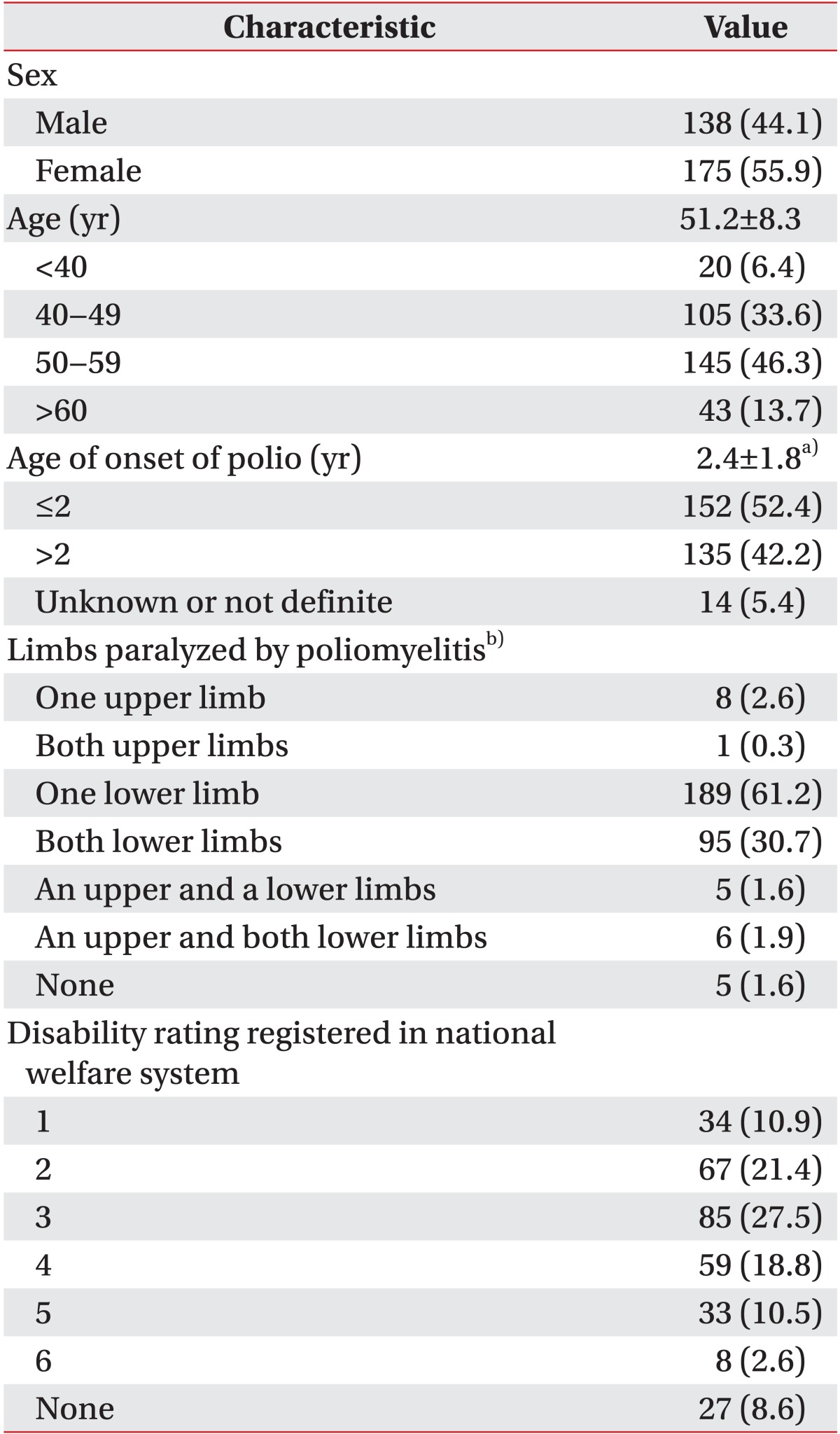1. Seibil VB, Malyshkina LP. Poliomyelitis eradication is a visible unsolved problem in the coming years. Vopr Virusol 2011;56:41-44. PMID:
21427955.
2. Bhutta ZA. The last mile in global poliomyelitis eradication. Lancet 2011;378:549-552. PMID:
21664681.


3. Doshi SJ, Sandhu HS, Venczel LV, Hymbaugh KJ, Deshpande JM, Pallansch MA, et al. Poliomyelitis-related case-fatality ratio in India, 2002-2006. Clin Infect Dis 2011;53:13-19. PMID:
21653297.



4. Trojan DA, Cashman NR. Post-poliomyelitis syndrome. Muscle Nerve 2005;31:6-19. PMID:
15599928.


5. Elrod LM, Jabben M, Oswald G, Szirony GM. Vocational implications of post-polio syndrome. Work 2005;25:155-161. PMID:
16131745.

6. Jubelt B, Drucker J. Post-polio syndrome: an update. Semin Neurol 1993;13:283-290. PMID:
8272600.



7. Dalakas M, Illa I. Post-polio syndrome: concepts in clinical diagnosis, pathogenesis, and etiology. Adv Neurol 1991;56:495-511. PMID:
1853779.

8. Trojan DA, Gendron D, Cashman NR. Electrophysiology and electrodiagnosis of the post-polio motor unit. Orthopedics 1991;14:1353-1361. PMID:
1784551.


9. Kang JH, Lin HC. Comorbidity profile of poliomyelitis survivors in a Chinese population: a population-based study. J Neurol 2011;258:1026-1033. PMID:
21279517.


10. Nielsen NM, Rostgaard K, Askgaard D, Skinhoj P, Aaby P. Life-long morbidity among Danes with poliomyelitis. Arch Phys Med Rehabil 2004;85:385-391. PMID:
15031822.


11. Silver JK, Aiello DD. Polio survivors: falls and subsequent injuries. Am J Phys Med Rehabil 2002;81:567-570. PMID:
12172064.


12. Bickerstaffe A, Beelen A, Nollet F. Circumstances and consequences of falls in polio survivors. J Rehabil Med 2010;42:908-915. PMID:
21031286.


13. Ramlow J, Alexander M, LaPorte R, Kaufmann C, Kuller L. Epidemiology of the post-polio syndrome. Am J Epidemiol 1992;136:769-786. PMID:
1442743.



14. Dalakas MC. The post-polio syndrome as an evolved clinical entity: definition and clinical description. Ann N Y Acad Sci 1995;753:68-80. PMID:
7611661.


15. Windebank AJ, Litchy WJ, Daube JR, Iverson RA. Lack of progression of neurologic deficit in survivors of paralytic polio: a 5-year prospective population-based study. Neurology 1996;46:80-84. PMID:
8559425.


16. Wekre LL, Stanghelle JK, Lobben B, Oyhaugen S. The Norwegian Polio Study 1994: a nation-wide survey of problems in long-standing poliomyelitis. Spinal Cord 1998;36:280-284. PMID:
9589529.



17. Windebank AJ, Litchy WJ, Daube JR. Prospective cohort study of polio survivors in Olmsted County, Minnesota. Ann N Y Acad Sci 1995;753:81-86. PMID:
7611662.


18. Klein MG, Braitman LE, Costello R, Keenan MA, Esquenazi A. Actual and perceived activity levels in polio survivors and older controls: a longitudinal study. Arch Phys Med Rehabil 2008;89:297-303. PMID:
18226654.


19. Gilhus NE, Barnes M, Brainin M. European handbook of neurological management. 2nd ed. Hoboken, NJ: Wiley-Blackwell; 2011.
20. Ivanyi B, Nollet F, Redekop WK, de Haan R, Wohlgemuht M, van Wijngaarden JK, et al. Late onset polio sequelae: disabilities and handicaps in a populationbased cohort of the 1956 poliomyelitis outbreak in The Netherlands. Arch Phys Med Rehabil 1999;80:687-690. PMID:
10378496.


21. Farbu E, Gilhus NE. Former poliomyelitis as a health and socioeconomic factor: a paired sibling study. J Neurol 2002;249:404-409. PMID:
11967644.


22. Burger H, Marincek C. The influence of post-polio syndrome on independence and life satisfaction. Disabil Rehabil 2000;22:318-322. PMID:
10877485.


23. Halstead LS, Rossi CD. Post-polio syndrome: clinical experience with 132 consecutive outpatients. Birth Defects Orig Artic Ser 1987;23:13-26. PMID:
3620612.


24. Halstead LS. Post-polio syndrome. Sci Am 1998;278:42-47. PMID:
9532770.

25. Lee KA, Lee CK. Clinical features of post-polio syndrome patients in Korea. J Korean Acad Rehabil Med 2000;24:517-526.
26. Bertolasi L, Acler M, dall'Ora E, Gajofatto A, Frasson E, Tocco P, et al. Risk factors for post-polio syndrome among an Italian population: a case-control study. Neurol Sci 2012;33:1271-1275. PMID:
22246456.


27. Research and clinical aspects of the late effects of poliomyelitis. Second research symposium. Warm Springs, Georgia, September 5-7, 1986. Proceedings. Birth Defects Orig Artic Ser 1987;23:1-363.
28. Dalakas MC, Elder G, Hallett M, Ravits J, Baker M, Papadopoulos N, et al. A long-term follow-up study of patients with post-poliomyelitis neuromuscular symptoms. N Engl J Med 1986;314:959-963. PMID:
3007983.


29. Ragonese P, Fierro B, Salemi G, Randisi G, Buffa D, D'Amelio M, et al. Prevalence and risk factors of postpolio syndrome in a cohort of polio survivors. J Neurol Sci 2005;236:31-35. PMID:
16014307.


30. Mohammad AF, Khan KA, Galvin L, Hardiman O, O'Connell PG. High incidence of osteoporosis and fractures in an aging post-polio population. Eur Neurol 2009;62:369-374. PMID:
19797901.


31. Goerss JB, Atkinson EJ, Windebank AJ, O'Fallon WM, Melton LJ 3rd. Fractures in an aging population of poliomyelitis survivors: a community-based study in Olmsted County, Minnesota. Mayo Clin Proc 1994;69:333-339. PMID:
8170177.


32. Haziza M, Kremer R, Benedetti A, Trojan DA. Osteoporosis in a postpolio clinic population. Arch Phys Med Rehabil 2007;88:1030-1035. PMID:
17678666.


33. Zeilig G, Weingarden H, Shemesh Y, Herman A, Heim M, Zeweker M, et al. Functional and environmental factors affecting work status in individuals with longstanding poliomyelitis. J Spinal Cord Med 2012;35:22-27. PMID:
22330187.



34. Ostlund G, Wahlin A, Sunnerhagen KS, Borg K. Post polio syndrome: fatigued patients a specific subgroup? J Rehabil Med 2011;43:39-45. PMID:
21174052.


35. Stoelb BL, Carter GT, Abresch RT, Purekal S, McDonald CM, Jensen MP. Pain in persons with postpolio syndrome: frequency, intensity, and impact. Arch Phys Med Rehabil 2008;89:1933-1940. PMID:
18929021.



36. Tiffreau V, Rapin A, Serafi R, Percebois-Macadre L, Supper C, Jolly D, et al. Post-polio syndrome and rehabilitation. Ann Phys Rehabil Med 2010;53:42-50. PMID:
20044320.















